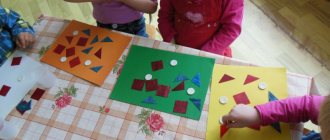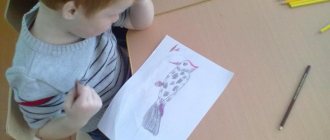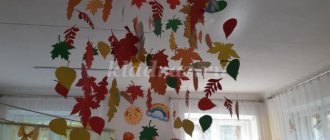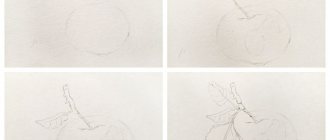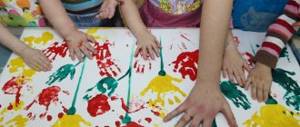Idea No. 1. Intersecting circles and markers.
Fill a sheet of paper with intersecting circles, tracing around a roll of tape.
Intersecting circles
Now you need to color the pattern so that adjacent segments are of different colors.
Funny circles
bright circles
Idea No. 2. Wax crayons and watercolors.
What if, as an experiment, you outline the tape not with a felt-tip pen, but with wax crayons?
Now paint the work with watercolors.
bright rings
By the way, see more ideas about painting with watercolors and wax crayons. And we continue.
DIY friendship rug in kindergarten - Mom and Me
Anastasia Sycheva
Educational mat “Road”
Goal: implementation of these tasks through all types of children's activities aimed at developing in children the creativity and personality of the child.
Objectives of the educational mat :
* Stimulate development processes in children
* Develop sensorimotor coordination, fine motor skills of the hands;
* Develop spatial orientation, promote understanding of the concepts of “up”, “down”, “right”, “left”;
*Promote speech development ;
* Develop children's creativity
I present to you a handmade didactic manual designed for working with children of any age on the development of fine motor skills and speech.
It has long been no secret to anyone that the development of fine motor skills (flexibility and accuracy of finger movements)
and tactile sensitivity is a powerful stimulus
for the development of children’s perception , attention, memory, thinking and speech.
Having not much teaching experience, while observing children, I noticed that when choosing a toy for play activities, a child pays attention to its color, texture, and the material from which it is made.
Educational rugs help children develop many qualities, such as memory, attention, the ability to find dependencies and patterns, and many others.
This is a gas station
Garage
Washing
Car service
Source: www.maam.ru
Idea No. 3. Draw on a piece of notebook paper.
Draw intersecting circles on a notebook sheet with a ruler. You need to color the circles, alternating a strip that is completely painted and a strip that is filled with strokes.
Idea No. 4. Draw circles on a piece of checkered paper with tape.
The essence of the idea is that on a piece of notebook paper we trace a roll of tape on the inside and outside with a black pen.
simple rings
Now we color the squares in the rings with colored pens.
To make the work original, you can paint only half of the ring.
Idea No. 5. Soap bubbles from circles.
For advanced draftsmen I would like to suggest drawing using a compass.
You need to draw a circle on the sheet with the maximum possible radius. And inside the circle there is a circle with a radius half the size, and next to it there is another one, which is half the size of the previous one. The circles must not intersect. We simply fill the remaining space with circles. The circles should touch each other, but not intersect. It turns out like this “foam”.
foam
Using felt-tip pens we turn our circles into bright soap bubbles.
Bubble
Project for preschool children “Friendship Rug” | Methodological developments
Project for preschool children “Friendship Rug”
Author: Yakovleva Anna Valerievna
Organization: MADOU No. 41 d/s "SWALLOW"
Locality: Republic of Buryatia, Ulan-Ude
Topics: socialization, communication of preschool children, ability to resolve conflict situations.
Project name: " Friendship Rug "
Target group:
- Children
- Educators
- Parents
Project content:
The project is creative, role-playing, group and individual; has a socially significant focus, long-term (5 years)
Goal: creating a favorable atmosphere of direct, free communication and emotional intimacy.
Task:
- a sense of unity, cohesion, the ability to act in a team, the removal of bodily barriers;
- the ability to establish friendly relationships, notice the positive qualities of others and express this in words;
- ability to resolve conflict situations and overcome conflicts in communicating with each other;
— development of non-verbal and substantive methods of interaction;
Project implementation conditions
Children from 3 to 7 years old, teachers and parents, and a music director took part in the implementation of the project. No special additional training is required to implement the project.
Equipment and tools:
- “Friendship Rugs” is a bright, beautifully designed rug, the theme is according to the taste and color of the teacher, for example, in our garden there are such rugs as “The World of Baikal”, “Space”, “Friendship” and others. The purpose of the rugs is to distract the child’s attention, teach them to talk to each other and negotiate through games and plots. Children who have quarreled sit on it side by side, clasp their little fingers and, looking into each other’s eyes, say a little rhyme, come up with their own plot, a fairy tale. Children really like this kind and at the same time fun ritual. Resentments pass, and a smile appears to replace them!
The rug is rich in content, multifunctional, variable, easily transformed, accessible to students and safe to use. Can be used in any area of the group space. They can be used as didactic material and can be used as a means of solitude for the child.
- Games "Mirilki" - various games for resolving conflicts.
- Card index of communicative games for preschoolers, teachers and parents.
- For confidential conversations with children in the group, there are such corners and zones as: “Corner of Confidence”, “Corner for Friends”
- " One hundred
www.vospitatelds.ru
Idea No. 6 Mandala.
Draw a circle with a diameter of 18 cm. Divide it into 18 segments. Enter the numbers of the segments as indicated in the figure. Now connect lines 1 and 2, 2 and 3, etc. When you reach 18, connect with 1.
mandala
We color the resulting segments as our imagination dictates. Is it possible to fill the segments with what? In circles, of course! Today we have such a round drawing.
I hope I didn’t bore you with a story about endless circles!
I wish you to stock up on ideas for creativity all year round. And you can see my ideas for drawing with children here. More ideas for drawing with children.
All the best to you! (does this happen?) Until next time.
Drawing. "Rugs for cats and dogs"
Tasks. Learn to independently choose ready-made shapes (“mats”) and colors of felt-tip pens. Draw lines, dots, circles, flowers, leaves, partially paint over the surface of the leaf. Continue again
287
development of a plot and game plan, instilling in children a friendly attitude towards animals and caring for them.
Materials. 3-4 colored rugs made in advance by the teacher in the form of a square and a circle. Figures of cats and dogs, sculpted by children in a previous modeling lesson. Felt pens, easel.
decoration made of stripes, lines, circles, dots, flowers, leaves. Each child independently performs a basic decorative composition. Although the patterns are very simple, thanks to the combination of the background and bright-colored markers, a palette that is pleasant for the child’s perception is created.
If a child expresses a desire to decorate another “rug,” he should be given this opportunity. After the lesson, children place all the rugs on the floor to see the variety of shapes and color compositions from above. “You love your dogs and cats very much, that’s why you tried so hard and drew “rugs” for them. Now bring your animals and place them on the mats. Now your dogs and cats will rest on beautiful rugs,” says the teacher, concluding the lesson.
Children can also use their decorative works in games with dolls and decorate the doll’s “interior” with them. The teacher also offers colored forms for independent drawing with felt-tip pens in the evening, encourages children to examine the elements of the pattern, finding similarities and differences in them.
Preliminary work. Examination of decoratively decorated “rugs” of various shapes, illustrations by Yu. Vasnetsov for Russian folk tales “Mashenka and the Bear”, “Three Bears”, “Ryaba Hen”, nursery rhymes.
Contents of the lesson. The teacher addresses the children: “Now, guys, you know that cats and dogs live in houses, next to people who love them and take care of them. You have created your favorite animals and will also take care of them. What needs to be done to ensure that the cat and dog are warm and comfortable to rest? (Children's answers). Yes, they need to put a rug on the floor. Look, I brought multi-colored “rugs” (shows 3-4 square and round rugs on the easel). What beautiful stripes, flowers, circles are drawn on them. Cats and dogs will love sleeping on these “mats.” You guys, use felt-tip pens to draw a beautiful “rug” for your cat or dog (hands out animal figures) and decorate it with patterns of different colors.”
The teacher asks the children to choose the shape of a square or a circle (they are laid out on a separate table). Since all the “rugs” are of different colors, each child can independently choose the one he likes best in shape and color. Then the children begin decorating the “rug.” Thanks to the variety of backgrounds and decoration elements, the “rugs” turn out to be elegant and colorful. The teacher and the children admire their decorative
288
Actions with objects. "Pyramid with a surprise"
Tasks. Strengthen children's knowledge about the color of objects. Learn to select parts (rings) focusing on two properties at the same time - size and color. Use the technique of “surprise” to activate interest in the lesson, increase orientation and speech activity. Introduce folklore play stories that promote emotional and speech development.
Materials. High pyramid (height up to 1 m). A polyethylene ball (cross-section diameter 20-25 cm), on which the face of a matryoshka is depicted.
Contents of the lesson. The teacher places a tall pyramid in front of the kids and removes the top four rings, shows them to the children, names the color, and puts them on a nearby table.
The teacher invites the kids to remove all the rings one by one. Every baby has
| 289 |
19 Order 544
One ring at a time. The teacher offers to play with rings. Children look through the hole in the ring and place it on its edge. An adult shows how to roll a ring on the floor. Encourages kids to roll the rings in different directions across the entire floor area.
The teacher takes a small ring from the table, say green: “Who has green rings? Are the rings the same color as mine? At Alyosha and Masha's. Alyosha has a large green ring, Masha has a smaller one, and I have a very small one. Let’s put all the green rings on the stick: first the big one, then the smaller ones and the small ones.” Red rings are selected and strung in the same way, then blue and yellow. “What an interesting pyramid we have made!”
“Where is the lid?” - the teacher takes a plastic ball, places it on the tip of the rod, turning the back side towards the children. Children see a “wavy” pyramid covered with a round lid (ball). The teacher turns the ball to face the children. The kids see a matryoshka doll in front of them.
The teacher ties a blue scarf on the matryoshka’s head: “Look at the “skirt with frills” on the matryoshka and the blue scarf on its head!”
Children look at the nesting doll: the pyramid has turned into a nesting doll. The teacher suggests standing in a circle and singing a song to the nesting doll:
Wonderful Matryoshka, dance a little! We are happy to dance with you! Show off your outfits! Sundress - inflated, painted bell! Blue handkerchief - Everything is very beautiful!
(L. Pavlova)
(The song is sung to the tune of the Russian folk melody “Barynya” or the words are chanted.)
The teacher asks if the children like the matryoshka doll and invites her to the doll corner: “You, Matryoshka, don’t be bored! Come visit the dolls!” The matryoshka moves into the doll's corner.
The matryoshka disassembles in the absence of children and assembles into a pyramid. Placed near the teaching table. In subsequent classes, you can use other caps in the form of the head of a cockerel, chicken, bunny, cat, etc.
At the same time, the content of the lesson and folklore texts should reflect the image of the “surprise hero”.
290
Speech development. “Didi- lado- ladushki”
Tasks. Involve children in dialogue. Activate the dictionary of names of items of clothing and utensils, adjectives. Match words with conditional actions. In the process of onomatopoeia, develop speech hearing and the articulatory apparatus of children.
Materials. Toys: two dolls (preferably a boy and a girl); utensils: saucepan, frying pan, plate, ladle. Handkerchief.
Contents of the lesson. The teacher addresses the children: “Today is Dasha’s doll’s birthday. (Demonstrates a toy.) Dasha has dressed up and is waiting for guests. How did Dasha dress up? What did she wear?
Children look at the doll. The teacher demonstrates the dress, shoes, and apron. Names everything together with the children: “What color is Dasha’s dress? Shoes? Apron?" (Asks and answers together with the children.) Next, the teacher: “Dasha is preparing a treat for the guests. Bakes pancakes. Dasha took the pan and kneaded the dough. Bakes pancakes in a frying pan. He pours the dough into a ladle. Places the finished pancakes on a plate.” (The words are accompanied by actions with toys.) Then he conducts the following dialogue: “What does Dasha knead the dough in? (Children's answers.) Show how she kneads the dough. How does Dasha bake pancakes? (The teacher carries out the conditional actions together with the children.) What does Dasha use to bake pancakes? (In a frying pan.)"
“Who wants to help Dasha knead the dough? How do we pour the dough into the frying pan? Who will help? Who will put the pancakes on a plate? The teacher gives children the opportunity to play with toys.
Next he reads a nursery rhyme, accompanying the words with conditional actions.
Didi-lado-ladushki, Let's bake pancakes. Slap-slap, slam-slap, The dough was kneaded thoroughly. Whoosh, whoosh, whoosh, whoosh, the frying pans are hot. Didi-lado-ladushki, Hot pancakes.
(L. Yakhnin “Pancakes”)1
1Yakhnin L.
Nursery rhymes. - M.: EKSMO, 2004. P. 20. 19* 291
The nursery rhyme is read twice. The second time - with preparation and the children performing conditional actions.
“The pancakes are ready. Let's taste them. (Conditional actions: the doll Dasha treats.) What kind of pancakes? (Hot, hot, tasty, sweet - the teacher together with the children. Conjugate and reflected speech.) So the guests have arrived,” says the teacher. (The Denis doll appears.)
The dialogue plays out:
- Hello, Denis!
- Hello, Dasha. Congratulations on your birthday.
- Come on in, sit down. We will drink tea with pancakes.
Teacher: “How does Dasha treat you? What does she say? (Independent statements from children.) We tasted pancakes. We drank tea. Let's go dancing. And we will dance."
Children move onto the carpet. The teacher picks up the dolls. Children perform dance movements, accompanying them with onomatopoeia: didi-lado-ladushki, hot pancakes. (Repeat 3-4 times.)
“Now we’ll all play hide and seek,” the teacher suggests. - Sit on the carpet, close your eyes. (The teacher covers one of the dolls with a scarf.) Open your eyes. Who is hiding?
In the same way, toys and children are hidden alternately.
Then the children move to the play corner. They read the nursery rhyme in chorus, accompanying the words with expressive movements.
Modeling. "Bowl and saucer for cats and dogs"
Tasks. Learn how to sculpt from a whole piece of plasticine into a hollow shape, and supplement the sculpting with paper plastic. Continue to develop the plot and game concept. Learn to take care of pets.
Material. Animal figures previously sculpted by children, “rugs” they drew, plasticine, oilcloths, colored napkins for paper plastics.
Preliminary work. Games with sculpted figures up to
292
pets, looking at “rugs”, pictures, illustrations that show images of cats and dogs during feeding. Reading nursery rhymes, singing songs.
Contents of the lesson. The teacher asks the children about what they did in the previous lesson and clarifies their answers: “We sculpted pets (a cat and a dog). Animals should be cared for by adults and children. They need to be fed and taken for a walk. Your cats and dogs feel very good, because you guys love them and drew beautiful “rugs” for them. Let's see how cats and dogs relax." All children come to a table on which rugs are laid, and animals “sleep” on them. “The morning came, the cats and dogs woke up and wanted to eat. What will you feed them? You need to pour milk for the cat, and give the dog a bone. Where are the saucer and bowl? Look, guys! - the teacher addresses.
The children look under the table and around it, but do not find any dishes anywhere. "What to do? - asks the teacher. — We need to make a saucer for the cat and a bowl for the dog. Sit down at the tables and see how to sculpt. First, you need to roll out a lump of plasticine like a ball, then squeeze it in your palms (demonstration). Now you need to lift the edges with your fingers (demonstration). Then use one finger to make a hole in the middle of the saucer and bowl. The dishes are ready!”
Children perform all the steps, flatten the lump of plasticine, and lift the edges of the flat shape. Then the teacher suggests “pour milk for the cat into the saucer” (you need to tear off a piece of a white paper napkin and put it in the saucer). For a dog, the child needs to make a “bone” (roll a column) and put it in a bowl. Then the children place the saucer and bowl on the “mats” so that the cats and dogs can “eat.”
“Now they can play with the balls. Make lumps out of colored paper napkins,” the teacher suggests (creasing method). Children throw “balls to their cat or dog.” The game can continue two or three times. The “balls” are left on the “rug” so that their beloved animals can “play” again.
In the evening, the game situation can continue, acquiring the character of a dramatization game. For example, a child takes on the role of a mother cat whose kitten loves to run, jump, and play with other kittens. Children can also feed their favorite animals, put them to sleep, sing lullabies to them, etc.
293
Organization of children's games
The teacher tries, as far as possible, to ensure that all the children are busy playing with toys, playing, if not together yet, then at least next to each other, without interfering with or destroying someone else’s play. If a child is not able to organize his behavior, is not interested in certain toys, acts with them non-functionally (he drags the doll upside down by the leg, taps it on the floor, and simply throws the car); if he only likes the toy that is in the hands of another, then such a child himself does not play, and instantly destroys the play of others: he breaks buildings, takes away toys, etc. In this case, an individual organization of play activities is necessary, and the teacher begins to play with him, create a play situation specifically for him, include first one and then several play actions, united by a common plot. Gradually, the child masters conventional play actions and can play on his own for a short time. If he is still attracted only to other people's toys, the teacher gives him the same ones and explains that he should not disturb other children, but he can play in the same way; at the same time, the child learns to imitate the games of not only the teacher, but also the children.
You can try to unite children who have already mastered the initial forms of story-based play into independent play “pairs.” To do this, they are offered game material in which they have to use some objects in turn or together: for example, pour tea for the dolls from one teapot, load a common car, build a path for a car or a train together. In this case, the teacher does not play with the children, but monitors how they play with the proposed game material and intervenes only when conflicts arise.
In the group room and outdoors, new game plots are added, which the children were shown in class: pets, a cat and a dog (preferably several) take part in the kids’ games. Children can feed animals, give them milk, pet them, and take them for walks (for this you need to have several leashes); you can build a doghouse or lay rugs near the radiator to keep it warm. The plot “The dog is lost” may arise. The teacher brings a toy dog out to the area, tells it several times “Don’t run too far!”, and then, when the children are distracted by something, hides it
294
for a snowdrift, tree or veranda. Then everyone looks for the dog, finds it, rejoices, takes it home, and explains to each other that it will no longer run away. You can supplement this plot by saying that the dog in the snow caught a cold, got sick, call a doctor and treat it. Children make “balls” for dogs and cats from paper lumps, rugs from napkins and pieces of paper, bones from sticks, and boxes of dry food from cubes. Missing items are already easily replaced with a substitute item, and for many, with a word.
.
FEBRUARY. WEEK 22
Work planning
Direction of pedagogical work. The dominant content of this week - “Daddy's Holiday” - is revealed in conversations with looking at pictures and reading poems dedicated to the army and the holiday; on the topic of productive activities (constructing from crumpled paper and painting fireworks with paints, creating greeting cards for dads and grandfathers); on the topic of outdoor games. The teacher will enrich the gaming environment with appropriate attributes and will support the children’s desire to use them when acting out familiar and new game plots, taking into account the interests of boys and girls. The teacher will give recommendations to parents in advance: on Defender of the Fatherland Day (February 23), draw the children’s attention to the festive decorations of the streets and watch the festive fireworks together. Work on the development of thinking and speech will continue: the teacher will teach children to perform actions, focusing on a given feature of an object (size, color), constantly involve them in dialogue, encouraging them to answer questions, express wishes; Work will continue on the correct pronunciation of vowels and simple consonants. In physical education classes, children will practice running in a confined space and climbing through a vertical hoop.
